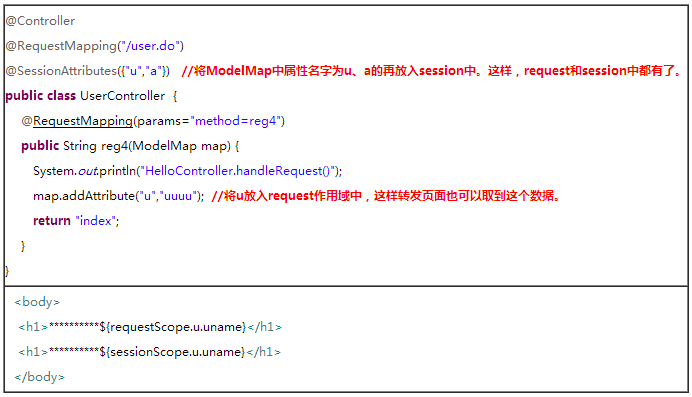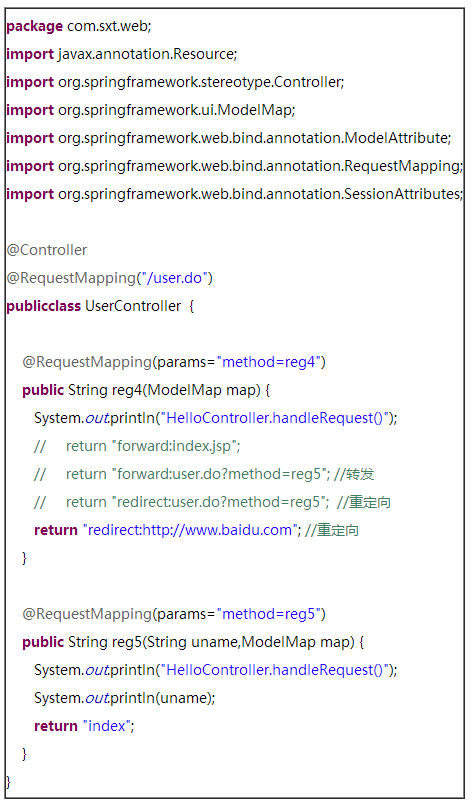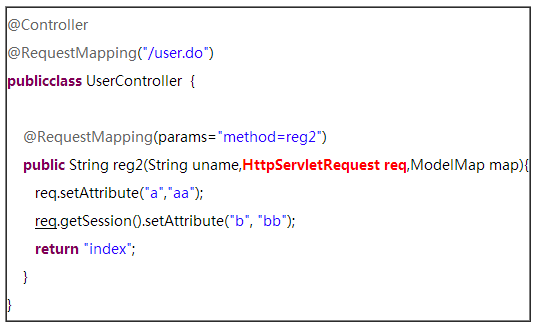SpringMVC 3.0 常用注解简介
1. 注册注解处理器
命名空间<context:component-scan/>
首先,如果要使注解工作,则必须配置component-scan 。该配置的功能为:启动包扫描功能,以便注册带有@Controller、@Service、@repository、@Component等注解的类成为spring的bean。例:<context:component-scanbase-package="com.tgb.web"/>
base-package 属性指定了需要扫描的类包,类包及其递归子包中所有的类都会被处理。还允许定义过滤器将基包下的某些类纳入或排除。
Spring支持以下4种类型的过滤方式:
1) 注解org.example.SomeAnnotation 将所有使用SomeAnnotation注解的类过滤出来
2) 类名指定org.example.SomeClass 过滤指定的类
3) 正则表达式com.kedacom.spring.annotation.web..* 通过正则表达式过滤一些类
4) AspectJ 表达式 org.example..*Service+ 通过AspectJ 表达式过滤一些类
正则表达式的过滤方式举例:
注解的过滤方式举例:
2. 启动Spring MVC 的注解功能,完成请求和注解POJO 的映射
2.1 @Controller—表示控制器
举例:
@Controller
public class SoftCreateController extendsSimpleBaseController {}
或者:
@Controller("softCreateController")
说明:
@Controller负责注册一个bean到spring上下文中,bean的ID默认为类名称开头字母小写
注意:
和Struts1一样,Spring的Controller是Singleton的。这就意味着会被多个请求线程共享。因此,我们将控制器设计成无状态类。
在spring 3.0中,通过@controller标注即可将class定义为一个controller类。有以上可知,为使spring能找到定义为controller的bean,需要在spring-context配置文件中增加如下定义:
<context:component-scanbase-package="com.sxt.web"/>
注:实际上,使用@component(下面有介绍),也可以起到@Controller同样的作用。
----------------------------------------------------------------------------------------------------------------------
2.2 @Service—表示业务处理层[一般在serviceImpl]
举例:
@ Service
public class SoftCreateServiceImpl implements ISoftCreateService{}
或者:
@Service("softCreateServiceImpl")
说明:
@Service负责注册一个bean到spring上下文中,bean的ID默认为类名称开头字母小写
2.3 @Repository—表示持久层[一般在daoImpl]
与@Controller、@Service类似,都是向spring上下文中注册bean,不在赘述。
----------------------------------------------------------------------------------------------------------------------
2.4 @Component(不推荐使用)—当你的类不清楚是哪一层的时候使用该注解
@Component
@Component是所有受Spring管理组件的通用形式,Spring还提供了更加细化的注解形式: @Repository、@Service、@Controller,它们分别对应存储层Bean,业务层Bean,和展示层Bean。
目前版本(2.5)中,这些注解与@Component的语义是一样的,完全通用,在Spring以后的版本中可能会给它们追加更多的语义。所以,我们推荐使用@Repository、@Service、@Controller来替代@Component。
----------------------------------------------------------------------------------------------------------------------
2.5 @Resource
例如:
@Resource
private DataSource dataSource; // injectthe bean named 'dataSource'
或者:
@Resource(name="dataSource")
@Resource(type=DataSource.class)
说明:
@Resource默认按bean的name进行查找,如果没有找到会按type进行查找,此时与@Autowired类似
在没有为 @Resource注解显式指定 name属性的前提下,如果将其标注在BeanFactory类型、ApplicationContext类型、ResourceLoader类型、ApplicationEventPublisher类型、MessageSource类型上,那么 Spring 会自动注入这些实现类的实例,不需要额外的操作。此时name属性不需要指定(或者指定为""),否则注入失败;
----------------------------------------------------------------------------------------------------------------------
2.6 @Autowired
例如:
@Autowired
private ISoftPMService softPMService;
或者:
@Autowired(required=false)
private ISoftPMService softPMService = newSoftPMServiceImpl();
说明:
Ø @Autowired根据bean类型从spring上线文中进行查找,注册类型必须唯一,否则报异常。与@Resource的区别在于,@Resource允许通过bean名称或bean类型两种方式进行查找@Autowired(required=false)表示,如果spring上下文中没有找到该类型的bean时,才会使用new SoftPMServiceImpl();
Ø @Autowired标注作用于 Map类型时,如果 Map的 key 为 String类型,则 Spring会将容器中所有类型符合 Map的 value 对应的类型的 Bean增加进来,用 Bean的 id或 name作为 Map的 key。
Ø @Autowired还有一个作用就是,如果将其标注在 BeanFactory类型、ApplicationContext类型、ResourceLoader类型、ApplicationEventPublisher类型、MessageSource类型上,那么 Spring会自动注入这些实现类的实例,不需要额外的操作。
----------------------------------------------------------------------------------------------------------------------
2.7 @RequestMapping
类:
方法:
说明:
@RequestMapping可以声明到类或方法上
实例:
- package com.sxt.web;
- import javax.annotation.Resource;
- import org.springframework.stereotype.Controller;
- import org.springframework.web.bind.annotation.RequestMapping;
- import com.sxt.service.UserService;
- @Controller
- @RequestMapping("/user.do")
- public class UserController {
- @Resource
- private UserService userService;
- //http://localhost:8080/springmvc02/user.do?method=reg&uname=zzzz
- @RequestMapping(params="method=reg")
- public String reg(String uname) {
- System.out.println("HelloController.handleRequest()");
- userService.add(uname);
- return "index";
- }
- public UserService getUserService() {
- return userService;
- }
- public void setUserService(UserService userService) {
- this.userService = userService;
- }
- }
参数绑定说明:
如果我们使用以下的 URL请求:
http://localhost/bbtForum.do?method=listBoardTopic&topicId=1&userId=10&userName=tom
topicIdURL参数将绑定到topicId入参上,而userId和userName URL参数将绑定到user对象的userId和userName属性中。和URL请求中不允许没有topicId参数不同,虽然User的userId属性的类型是基本数据类型,但如果URL中不存在userId参数,Spring也不会报错,此时user.userId值为0。如果 User 对象拥有一个dept.deptId的级联属性,那么它将和dept.deptId URL参数绑定。
----------------------------------------------------------------------------------------------------------------------
2.8 @RequestParam
说明:
一般用于将指定的请求参数付给方法中形参。示例代码如下:
- @RequestMapping(params="method=reg5")
- public String reg5(@RequestParam("name")String uname,ModelMap map) {
- System.out.println("HelloController.handleRequest()");
- System.out.println(uname);
- return "index";
- }
这样,就会将name参数的值付给uname。当然,如果请求参数名称和形参名称保持一致,则不需要这种写法。
参数绑定说明:
@RequestParam("id")
http://localhost/bbtForum.do?method=listBoardTopic&id=1&userId=10&userName=tom
listBoardTopic(@RequestParam("id")inttopicId,User user)中的topicId绑定到id这个 URL参数,那么可以通过对入参使用@RequestParam注解来达到目的
@RequestParam(required=false):参数不是必须的,默认为true
@RequestParam(value="id",required=false)
请求处理方法入参的可选类型
• Java基本数据类型和String
默认情况下将按名称匹配的方式绑定到URL参数上,可以通过@RequestParam注解改变默认的绑定规则
----------------------------------------------------------------------------------------------------------------------
2.9 @Scope
例如:
说明:
在使用XML定义Bean时,可以通过bean的scope属性来定义一个Bean的作用范围,同样可以通过@Scope注解来完成。
@Scope中可以指定如下值:
singleton:定义bean的范围为每个spring容器一个实例(默认值)
prototype:定义bean可以被多次实例化(使用一次就创建一次)
request:定义bean的范围是http请求(springMVC中有效)
session:定义bean的范围是http会话(springMVC中有效)
global-session:定义bean的范围是全局http会话(portlet中有效)
----------------------------------------------------------------------------------------------------------------------
2.10 @SessionAttributes
说明:
Spring允许我们有选择地指定 ModelMap中的哪些属性需要转存到 session中,以便下一个请求属对应的 ModelMap的属性列表中还能访问到这些属性。这一功能是通过类定义处标注 @SessionAttributes注解来实现的。@SessionAttributes只能声明在类上,而不能声明在方法上。
例如:
@SessionAttributes("currUser") //将ModelMap中属性名为currUser的属性
@SessionAttributes({"attr1","attr2"})
@SessionAttributes(types = User.class)
@SessionAttributes(types = {User.class,Dept.class})
@SessionAttributes(types ={User.class,Dept.class},value={"attr1","attr2"})
实例:
----------------------------------------------------------------------------------------------------------------------
2.11 @ModelAttribute
这个注解可以跟@SessionAttributes配合在一起用。可以将ModelMap中属性的值通过该注解自动赋给指定变量。
示例代码如下:
- import javax.annotation.Resource;
- import org.springframework.stereotype.Controller;
- import org.springframework.ui.ModelMap;
- import org.springframework.web.bind.annotation.ModelAttribute;
- import org.springframework.web.bind.annotation.RequestMapping;
- import org.springframework.web.bind.annotation.SessionAttributes;
- @Controller
- @RequestMapping("/user.do")
- @SessionAttributes({"u","a"})
- public class UserController {
- @RequestMapping(params="method=reg4")
- public String reg4(ModelMap map) {
- System.out.println("HelloController.handleRequest()");
- map.addAttribute("u","kobe");
- return "index";
- }
- @RequestMapping(params="method=reg5")
- //将属性u的值赋给形参uname
- public String reg5(@ModelAttribute("u")String uname,ModelMap map) {
- System.out.println("HelloController.handleRequest()");
- System.out.println(uname);
- return "index";
- }
- }
----------------------------------------------------------------------------------------------------------------------
2.12 @InitBinder
说明:
如果希望某个属性编辑器仅作用于特定的 Controller,可以在 Controller中定义一个标注 @InitBinder注解的方法,可以在该方法中向 Controller了注册若干个属性编辑器
例如:
----------------------------------------------------------------------------------------------------------------------
2.13 @Required
例如:
说明:
@ required负责检查一个bean在初始化时其声明的 set方法是否被执行,当某个被标注了 @Required的 Setter方法没有被调用,则 Spring在解析的时候会抛出异常,以提醒开发者对相应属性进行设置。 @Required注解只能标注在 Setter方法之上。因为依赖注入的本质是检查 Setter方法是否被调用了,而不是真的去检查属性是否赋值了以及赋了什么样的值。如果将该注解标注在非 setXxxx()类型的方法则被忽略。
----------------------------------------------------------------------------------------------------------------------
2.14 @Qualifier
例如:
说明:
使用@Autowired时,如果找到多个同一类型的bean,则会抛异常,此时可以使用 @Qualifier("beanName"),明确指定bean的名称进行注入,此时与 @Resource指定name属性作用相同。
----------------------------------------------------------------------------------------------------------------------
2.15 @ResponseBody
这个注解可以直接放在方法上,表示返回类型将会直接作为HTTP响应字节。流输出(不被放置在Model,也不被拦截为视图页面名称)。可以用于ajax。
3. 常用点
3.1 Controller类中方法返回值的处理
1. 返回string(建议)
a) 根据返回值找对应的显示页面。路径规则为:prefix前缀+返回值+suffix后缀组成
b) 代码如下:

2. 也可以返回ModelMap、ModelAndView、map、List、Set、Object、无返回值。一般建议返回字符串!
3.2 请求转发和重定向
代码示例:
访问reg4方法,既可以看到效果。
3.3 获得request对象、session对象
普通的Controller类,示例代码如下:










